
Pampas Grass is a tall tussock growing to over 3m. It has numerous fluffy seedheads with sharp, cutting leaves 1-2m long. Flower heads occur in summer with each plume producing up to 100,000 seeds. Leaves contain silica which can irritate the eyes, nose, throat and lungs and are highly flammable when dry.
Family: Poaceae
Origin: South America and New Zealand
Habit: clumping grass about 1 – 1.5 m across, with fluffy flower heads on tall stems
Leaves: finely serrated on the edges
Flowers: white, pink or mauve, and present from mid-March to late May
Fruit: plants can produce up to 100,000 seeds per flower head
Roots: up to 3.5 m deep
Dispersal: Wind spreads the seed. Garden plants are often the source of new infestations. Pampas grasses can spread out via rhizomes
General Biosecurity Duty
All plants are regulated with a general biosecurity duty to prevent, eliminate or minimise any biosecurity risk they may pose. Any person who deals with any plant, who knows (or ought to know) of any biosecurity risk, has a duty to ensure the risk is prevented, eliminated or minimised, so far as is reasonably practicable.
Regional Recommended Measure
This Regional Recommended Measure applies to Cortaderia jubata (pink pampas grass)
Land managers mitigate the risk of the plant being introduced to their land. Land managers prevent spread from their land where feasible. Land managers reduce the impact on priority assets.
The plant should not be bought, sold, grown, carried or released into the environment.
Control
Small plants can be hand pulled. Slash back the sharp leaves of large tussocks before grubbing out to remove all rhizomes. Bag seed heads.
